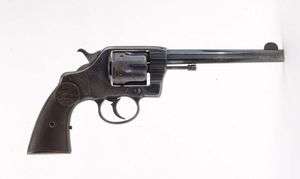Colt M1892
| Colt M1892 | |
|---|---|
 | |
| Type | Revolver |
| Place of origin |
|
| Service history | |
| Used by |
US Army, US Navy, Federal Army |
| Wars |
Spanish–American War, Philippine–American War, Boxer Rebellion, Mexican Revolution, World War I |
| Production history | |
| Designer | Colt |
| Designed | 1892 |
| Manufacturer | Colt |
| Produced | 1892–1908 [1] |
| Specifications | |
| Weight | 2.07 pounds (.94 kg) |
| Length | 11.5 inches (292 mm) |
| Barrel length | 6 inches (152 mm) |
|
| |
| Cartridge | .38 Long Colt, .41 Long Colt |
| Action | Double Action revolver |
| Muzzle velocity | 770 ft/s (235 m/s) |
| Feed system | 6-round cylinder, single-shot |
| Sights | Iron sights |
The M1892 Colt Army & Navy was the first general issue double-action with a swing-out cylinder revolver used by the U.S. military.[2]
Overview

In 1892 the gun was adopted by the Army in .38 Long Colt caliber, and the revolver was given the appellation New Army and Navy. Initial experience with the gun caused officials to request some improvements. This would be an ongoing condition, resulting in Models 1892, 1894, 1895, 1896, 1901 and 1903, as well as a Model 1905 Marine Corps variant.[2]
Features
The revolver featured a counter-clockwise rotating cylinder, which could be opened for loading and ejection by simply pulling back on a catch mounted on the left side of the frame behind the recoil shield. It was easily manipulated by the thumb of the right hand, and upon release the cylinder could be poked out sideways with the shooter's forefinger. Empty cases were removed by simply pushing back on an ejector rod to activate a star extractor. The six-shooter could then be quickly reloaded and the cylinder clicked back into place.[2]
Sights
Sights were the basic rounded front blade and topstrap notch. The finish on all military revolvers was blue, though civilian guns could be had nickeled or with other special finishes and embellishments.[2]
History and usage
The M1892's counter-clockwise cylinder rotation tended to force the cylinder out of alignment with the frame over time, and this was exacerbated by relatively weak lockwork used to time or match individual chambers to the barrel.[3] In 1908, Colt improved and strengthened the lockwork, and changed the cylinder rotation to a clockwise movement.
A Model 1892 revolver was recovered from the USS Maine after it exploded in Havana Harbor in 1898. It was presented to then-Assistant Secretary of the Navy Theodore Roosevelt, who would later become President of the United States. Roosevelt brandished this pistol to rally his Rough Riders during the famed charge up San Juan Hill on July 1, 1898. This revolver was on display at Sagamore Hill and was stolen from there in 1963, recovered and then stolen again in 1990. It was recovered in 2006 and returned to Sagamore Hill on June 14, 2006.[4][5]
This revolver was thought of as a decent handgun for its time, but complaints arose from the military concerning the revolver's cartridge chambering. Beginning in 1899, combat reports arose from the Philippines campaign regarding the poor performance of the M1892's .38-caliber ammunition. Specifically, users complained that the .38 bullet repeatedly failed to stop charging enemy tribesmen at close ranges, even when hit multiple times. The complaints caused the U.S. Army to hurriedly issue stocks of .45 caliber revolvers, and played a central role in its decision to replace the M1892 with the .45 Colt M1909 New Service revolver in 1909.[6]
In the rush to furnish arms to the rapidly expanding Navy after the United States entered World War I, surplus stocks of these old Colts were inspected, refurbished as needed and then issued to officers as a substitute standard side arm.
Modifications and variants
During its service life, the M1892 received modifications to the basic design, including cylinder lockwork, the addition (in 1894) of trigger and hammer locks, different barrel markings, the addition of a lanyard ring, and a reduction of bore diameter in an effort to increase accuracy.[2]
Safety caution
Both .38 Special and .357 Magnum will chamber in Colt New Army revolvers, due to the straight walled chambers, however, this should not be done under any circumstances, due to dangerous pressure levels, up to three times what the New Army is designed for.
References
- ↑ Guns of the Old West: An Illustrated ... - Google Books. Books.google.com. 2002-05-21. Retrieved 2011-08-12.
- 1 2 3 4 5 Sapp, Rick (2007). Standard Catalog of Colt Firearms. F+W Media, Inc,. pp. 96–97. ISBN 978-0-89689-534-8.
- ↑ Velleux, David L., U.S. Revolver Models 1889, 1892, 1894, 1895 and 1896
- ↑ Saxon, Wolfgang (April 8, 1990). "Theodore Roosevelt's Gun Stolen". New York Times.
- ↑ "Roosevelt's Revolver Stolen 1895 Pistol Returned in New York". FBI. June 2, 2006.
- ↑ James, Gary (March 1, 2008). "Colt New Army & Navy Revolver". Handguns Magazine.
